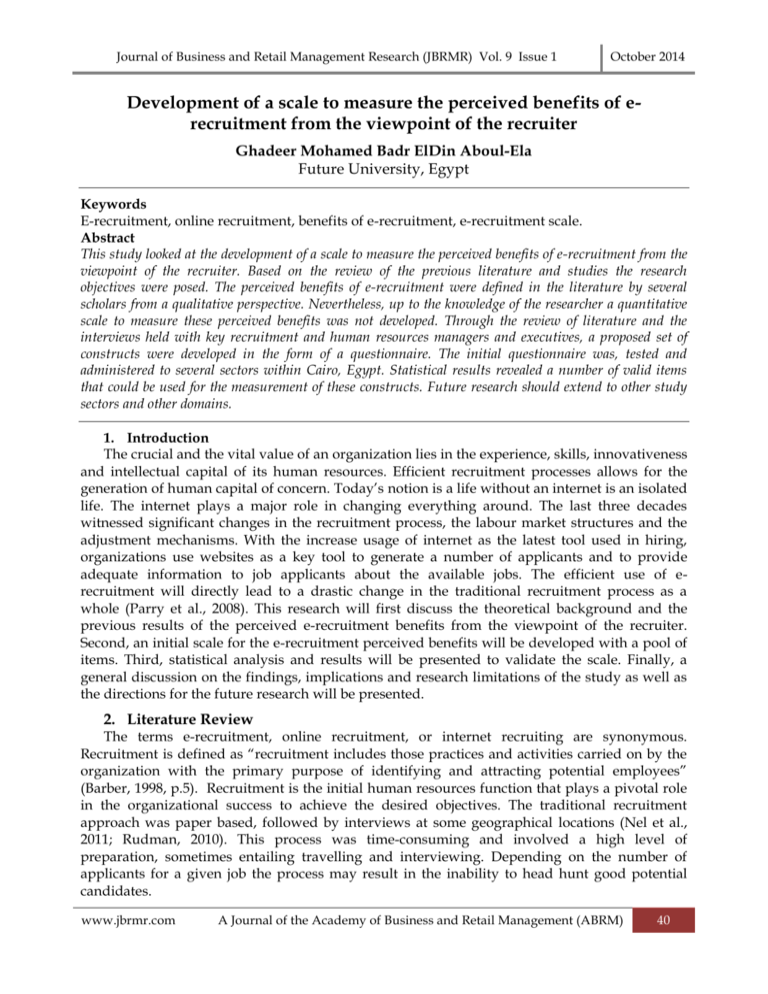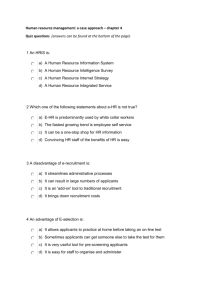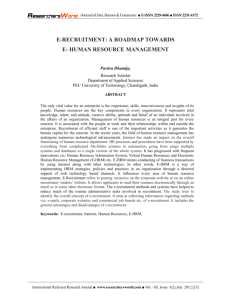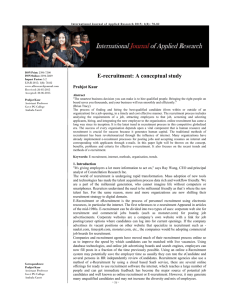Development of a scale to measure the perceived benefits of e
advertisement

Journal of Business and Retail Management Research (JBRMR) Vol. 9 Issue 1 October 2014 Development of a scale to measure the perceived benefits of erecruitment from the viewpoint of the recruiter Ghadeer Mohamed Badr ElDin Aboul-Ela Future University, Egypt Keywords E-recruitment, online recruitment, benefits of e-recruitment, e-recruitment scale. Abstract This study looked at the development of a scale to measure the perceived benefits of e-recruitment from the viewpoint of the recruiter. Based on the review of the previous literature and studies the research objectives were posed. The perceived benefits of e-recruitment were defined in the literature by several scholars from a qualitative perspective. Nevertheless, up to the knowledge of the researcher a quantitative scale to measure these perceived benefits was not developed. Through the review of literature and the interviews held with key recruitment and human resources managers and executives, a proposed set of constructs were developed in the form of a questionnaire. The initial questionnaire was, tested and administered to several sectors within Cairo, Egypt. Statistical results revealed a number of valid items that could be used for the measurement of these constructs. Future research should extend to other study sectors and other domains. 1. Introduction The crucial and the vital value of an organization lies in the experience, skills, innovativeness and intellectual capital of its human resources. Efficient recruitment processes allows for the generation of human capital of concern. Today’s notion is a life without an internet is an isolated life. The internet plays a major role in changing everything around. The last three decades witnessed significant changes in the recruitment process, the labour market structures and the adjustment mechanisms. With the increase usage of internet as the latest tool used in hiring, organizations use websites as a key tool to generate a number of applicants and to provide adequate information to job applicants about the available jobs. The efficient use of erecruitment will directly lead to a drastic change in the traditional recruitment process as a whole (Parry et al., 2008). This research will first discuss the theoretical background and the previous results of the perceived e-recruitment benefits from the viewpoint of the recruiter. Second, an initial scale for the e-recruitment perceived benefits will be developed with a pool of items. Third, statistical analysis and results will be presented to validate the scale. Finally, a general discussion on the findings, implications and research limitations of the study as well as the directions for the future research will be presented. 2. Literature Review The terms e-recruitment, online recruitment, or internet recruiting are synonymous. Recruitment is defined as “recruitment includes those practices and activities carried on by the organization with the primary purpose of identifying and attracting potential employees” (Barber, 1998, p.5). Recruitment is the initial human resources function that plays a pivotal role in the organizational success to achieve the desired objectives. The traditional recruitment approach was paper based, followed by interviews at some geographical locations (Nel et al., 2011; Rudman, 2010). This process was time-consuming and involved a high level of preparation, sometimes entailing travelling and interviewing. Depending on the number of applicants for a given job the process may result in the inability to head hunt good potential candidates. www.jbrmr.com A Journal of the Academy of Business and Retail Management (ABRM) 40 Journal of Business and Retail Management Research (JBRMR) Vol. 9 Issue 1 October 2014 E-recruitment refers to the practices of advertising companies’ vacancies online (Galanaki, 2002), it’s one of the well-recognized worldwide trends of the human resources functions.(Darrag et al., 2010) identified e-recruitment as a linking pin between the potential candidates and the vacant positions in an organization. The researcher defines e-recruitment as the process of utilizing technology through the usage of various electronic means to perform all the traditional recruitment functions efficiently and effectively. Rudman (2010) views erecruitment as the selection of potential candidates applying for a job through the usage of internet. Using this method the applicant is likely to send the CV electronically to the advertisers' website. This will allow the recruiter to screen among all the CVs received and to filter out using technology filters and buffers, the suitable candidates for selection (Finn, 2000). The virtual recruiting environment will vary in the level of sophistication depending on the level of technology used and the scope of activities it covers. E-recruitment can be divided into two main categories: a) corporate website used for recruitment and b) commercial job boards where job advertisements are posted (Parry, et al., 2009). The choice of any of these methods to adopt relies on the organizations’ size, needs, and recruitment budget. E-recruitment can play a drastic role in the fierce competition whereby the ability to attract the appropriate employees becomes pivotal to the organizations’ success. Harris (2004) makes a clear distinction between we-find-you approaches and you-find-us approaches. We- find- you approaches refer to the methods whereby the recruiter searches for applicants while you – find us approaches refer to methods whereby the potential applicant searches for the organization (Harris, 2004). We-findyou approaches include: searching through resumes on a job board, web-event recruitment, relationship recruiting, using the service of aggregator sites and is also known as e-recruiting (Lievens et al, 2003). Examples of you- find – us approaches: participation in online job fairs, and posting CVs on organizational websites. Much of the existing literature on the e-recruitment is quite general. While several studies have provided a highlight on the advantages of e-recruitment, no measurement tool or scale was developed up to the knowledge of the researcher to measure these perceived benefits from the viewpoint of the recruiter. Several studies focused on the effectiveness of the internet in the erecruitment process compared to the traditional recruitment methods highlighting the advantages and the disadvantages of using the e-recruitment (Feldman et al., 2002). Scholars explained how to improve the effectiveness of e-recruitment, treating both the applicants and the organizations as homogenous groups (Fister, 2001; Peters, 2001; Snell, 2001). Through the review of the previous literature on the e-recruitment perceived benefits, the researcher concluded the following named benefits: shorter recruiting cycle time (Kim et.al,2009), ability to attract passive job seekers (McDougall, 2001), e-recruitment provides global coverage at a constant basis (Mohamed,2002; McDougall, 2001;Baille, 1996;), opportunity to address specific labour market niches (Greengard et al., 1998), ability to reach a wider scope of applicants (Kim et.al.,2009), gives the organization a more up to date image (Williams et al., 1997), better quality of response (Pin et al., 2001), low costs (Dhamija, 2012;Williams et al., 1997), increases the chances to find the right candidates (Galanaki, 2002), facilitates geographical spread (CIPD, 2005;Mohamed et al., 2002; McDougall, 2001), quicker turnaround time/cost savings (Galanaki, 2002; Pin et al., 2001; Zusman et al., 2000), higher quality of applicants (Bartram, 2005; Breaugh et al., 2003; Epstein et al., 2003), provides a better opportunity for smaller companies (Pin et al., 2001), and shift from manual screening to the usage of automated human resources management practices (Bingham et al., 2002, Pin et al., 2001). www.jbrmr.com A Journal of the Academy of Business and Retail Management (ABRM) 41 Journal of Business and Retail Management Research (JBRMR) Vol. 9 Issue 1 October 2014 3. Research Objectives The present study attempts to propose a scale to measure the perceived benefits of e-recruitment from the viewpoint of the organization (recruiter). The research objectives are: 1. Review and summarize the previously proposed benefits from the previously documented literature 2. Develop and purify a scale to measure the perceived benefits of e-recruitment process from the viewpoint of the organization (recruiter) 3. Validate the scale of the perceived benefits 4. Research Methodology a) Step1: Item Generation The primary concern was to propose a list of items that will be used for the initial scale. The content validity was of a key concern (Schriesheim et al. 1993). The inductive approach was used to generate the list of proposed items through the review of the previous literature. This approach was used because according to the knowledge of the researcher there is little theory involved at the outset as one attempt to identify constructs and generate measures from individual responses. Bulter (1991) approach was followed; this entailed utilizing the inductive approach for the generation of items of the perceived benefits of e-recruitment. Semi-structured interviews with a number of 30 human resources managers and 10 recruitment supervisors from various industrial and services –oriented sectors were conducted. Participants were asked to list the benefits of e-recruitment that they perceived based on their experiences and interaction. The results were refined and used for the generation of the items. Common interview responses were summarized as: low costs, less time, ability to reach applicants from various countries, better quality of applicants, and sound image for the organization. b) Step2: Scale Development Questionnaires are the common method adopted to collect data in the field of research (Stone, 1978). At this stage, the researcher has identified a potential set of 40 items for the construct under consideration. Next, the researcher wanted to examine how well these items were appropriate to confirm the expectations about the proper structure of the measure. The 40 items were proposed to three human resources professors at Cairo University who contributed to the modification of 10 items from an expert background. The questionnaire was refined and modified for distribution. The sample chosen was several product-based and services-based organizations that used e-recruitment. The recruitment teams and the human resources managers, executives and supervisors were invited to fill in the questionnaires. The questionnaires were distributed and collected through the emails and were accompanied by a small video that explained to the participants the purpose of the questionnaires. A specialized organization in the field of research was contacted by the researcher to increase the ability to reach the largest possible number of participants. A sample of 130 organizations was targeted with a total number of 2000 questionnaires distributed to these organizations. A total of 1600 questionnaires were collected back valid and complete, with a response rate of 80%. The timeframe was a period of 4 months to collect the questionnaires. In developing the scale the following were considered. a) A choice of a representative sample of the population. The sample included: industrial organizations (35%), services organizations (20%), educational organizations (15%), governmental organizations (15%), and healthcare organizations (15%). www.jbrmr.com A Journal of the Academy of Business and Retail Management (ABRM) 42 Journal of Business and Retail Management Research (JBRMR) Vol. 9 Issue 1 October 2014 b) Reverse scored items have been avoided as they have shown to reduce the validity of the questionnaire responses (Schriesheim et al., 1981) and may introduce systematic error to a scale (Jackson et al,, 1993). c) The construction of the scale is based in the usage of several items to measure the identified dimensions of the perceived e-recruitment benefits. d) Short statements have been used e) Likert-type scales rating with 5 options ranging from strongly disagree to strongly agree have been used. c) Initial Questionnaire Through the review of literature and the results of the interviews conducted with the human resources managers and recruitment supervisors the researcher was able to group the perceived e-recruitment benefits under the umbrella of five main dimensions namely; saves time, geographical outreach, saves efforts, improved quality of applicants and sound organizational image. The researcher proposed eight items to measure each of these constructs. The items were not listed in order to avoid any level of biasness that may be present. The initial questionnaire is present in table (1), whereby: Saves time construct was measured by items numbered:1,6,11,17,23,25,31,36 Geographical outreach construct was measured by items numbered: 2,8,12,18,26,29,33,37 Saves efforts construct was measured by items numbered: 3,9,14,19,22,28,35,38 Improved quality of applicants construct was measured by items numbered: 4,7,15,20,24,27,31,39 Sound organizational image construct was measured by items numbered: 5,10,13,16,21,30,34,40 Table (1): E-recruitment perceived benefits initial proposed questionnaire # 1 2 3 4 5 6 7 8 9 10 11 12 13 14 15 16 17 18 19 20 Item E-recruitment saves a lot of time to our company The company's' recruitment efforts reach lots of applicants through e-recruitment E-recruitment helps our company to save lots of efforts through the utilization of technology E-recruitment provides better quality of applicants E-recruitment helps the company to gain an improved organizational image E-recruitment reduces the time taken for recruitment by our company E-recruitment can save the organization the costs of attracting unqualified applicants The company can reach several geographical locations through e-recruitment E-recruitment reduces the level of human efforts engaged in the recruitment process E-recruitment helps to create a sound image for the organization The time taken for e-recruitment process is less than that is allocated for traditional recruitment methods It's easier to get the required expertise from different countries through e-recruitment Companies adopting e-recruitment enjoy better organizational image as this reflects their up-todate upfront Using e-recruitment consumes less efforts as technology makes things easier E-recruitment allows the company to filter the qualified applicants through the adoption of technology buffers E-recruitment is used to create a better organizational image E-recruitment method is associated with the concept of time efficiency E-recruitment is the simplest method to reach several locations worldwide Using e-recruitment, will lead to a reduction in human efforts E-recruitment attracts more qualified applicants www.jbrmr.com A Journal of the Academy of Business and Retail Management (ABRM) 43 Journal of Business and Retail Management Research (JBRMR) Vol. 9 Issue 1 21 22 23 24 25 26 27 28 29 30 31 32 33 34 35 36 37 38 39 40 October 2014 Companies adopting e-recruitment enjoy an improved organizational image E-recruitment saves lots of efforts that are further utilized by the organization towards efficiency Our Company saves a lot of time when using e-recruitment E-recruitment reduces the chances of attracting unqualified applicants E - recruitment reduces the time taken for analyzing the data collected from applicants E-recruitment helps the organization to find worldwide recruitment sources E-recruitment helps in attracting more skilled applicants E-recruitment is a fast and an easy way to save human efforts E-recruitment allows a more diversity of applicants from various geographical locations to apply E-recruitment is a supporting tool that improves organizational image E-recruitment consumes less time E-recruitment increases the opportunity of attracting competent applicants E-recruitment allows us to reach the world easily Companies who work with e-recruitment will enjoy a vast growth in their organizational image E-recruitment saves human efforts which reflects on organizational efficiency E-recruitment saves time regarding matching applicants with the available vacancies E-recruitment is an efficient way to get access to applicants from various countries E-recruitment is a perfect tool to minimize human efforts E-recruitment can reduce the chances of attracting unqualified applicants E-recruitment reduces the barrier of attracting unqualified applicants through improved organizational image d) Step2: Scale Evaluation The objective of the previous stages in the scale development process was to create the measures that demonstrate validity and reliability. Factor analysis, internal consistency, and reliability would provide evidence for the construct validity (Cronbach et al., 1955). SpearmanBrown prophecy formulas have been used to reduce the number of items as they have been proven to be efficient without affecting reliability. The following section will present the statistical analysis and results for the proposed initial scale items. 5. Statistical Analysis and Results a) Descriptive Statistics: The questionnaires distributed included items related to the demographic statistics. The gathered data included: gender, management level, marital status, and education level. A summary of the demographic characteristics is presented in the following table Table (2): The demographic characteristics of the research study Demographic Characteristics Frequency Percentage (%) 761 839 47.6 52.4 Management Level Non - Managerial Middle - Management Top - Management Frequency 966 609 25 Percentage (%) 60.3 38.1 1.6 Marital Status Frequency 650 907 Percentage (%) 40.6 56.7 Gender Male Female Single Married www.jbrmr.com A Journal of the Academy of Business and Retail Management (ABRM) 44 Journal of Business and Retail Management Research (JBRMR) Vol. 9 Issue 1 Divorced Widow Educational Level University Graduate Masters October 2014 39 4 2.4 0.3 Frequency 1550 50 Percentage (%) 96.9 3.1 b) Reliability and Validity Results For the purpose of the research study the following statistical tools were used: 1. Factor analysis is a statistical tool used to describe variability among observed, correlated variables in terms of a potentially lower number of unobserved variables. It is commonly used in social and behavioural sciences. The standardized pattern of factor loading coefficient which is used within the analysis of this research study is 60%. 2. Inter-consistency coefficient is a statistical tool used to measure the degree of consistency among the various items. 3. Cronbach's Alpha is commonly used as an estimate of the reliability. 4. Spearman–Brown correlation coefficient measure of statistical dependence between two variables. It reflects the degree of homogeneity among variables. Table (3): Shows the results of the Factor Analysis based on Varimax Rotation # 1 2 3 4 5 6 7 8 9 10 11 12 13 14 15 16 17 Item E-recruitment saves a lot of time to our company The company's' recruitment efforts reach lots of applicants through e-recruitment E-recruitment helps our company to save lots of efforts through the utilization of technology E-recruitment provides better quality of applicants E-recruitment helps the company to gain an improved organizational image (X) E-recruitment reduces the time taken for recruitment by our company (X) E-recruitment can save the organization the costs of attracting unqualified applicants The company can reach several geographical locations through erecruitment E-recruitment reduces the level of human efforts engaged in the recruitment process (X) E-recruitment helps to create a sound image for the organization The time taken for e-recruitment process is less than that is allocated for traditional recruitment methods It's easier to get the required expertise from different countries through e-recruitment Companies adopting e-recruitment enjoy better organizational image as this reflects their up-to-date upfront (X) Using e-recruitment consumes less efforts as technology makes things easier E-recruitment allows the company to filter the qualified applicants through the adoption of technology buffers E-recruitment is used to create a better organizational image (X) E-recruitment method is associated with the concept of time www.jbrmr.com Factor 1 1 2 0.603 0.774* Factor 2 1 2 0.478 0.629 0.492 0.808* 0.508 0.439 0.619 0.640 0.446 0.559 0.514 0.470 0.671 0.766* 0.335 0.627 0.756* 0.389 0.815* 0.787* 0.576 0.422 0.472 0.637 0.768* 0.363 0.674 0.767* 0.422 0.608 0.746* 0.574 0.461 0.653 0.747* 0.338 0.691 0.587 0.449 0.774* 0.329 0.438 0.609 A Journal of the Academy of Business and Retail Management (ABRM) 0.759* 45 Journal of Business and Retail Management Research (JBRMR) Vol. 9 Issue 1 18 19 20 21 22 23 24 25 26 27 28 29 30 31 32 33 34 35 36 37 38 39 40 efficiency E-recruitment is the simplest method to reach several locations worldwide Using e-recruitment, will lead to a reduction in human efforts E-recruitment attracts more qualified applicants (X) Companies adopting e-recruitment enjoy an improved organizational image E-recruitment saves lots of efforts that are further utilized by the organization towards efficiency Our company saves a lot of time when using e-recruitment (X) E-recruitment reduces the chances of attracting unqualified applicants (X) E - recruitment reduces the time taken for analyzing the data collected from applicants E-recruitment helps the organization to find worldwide recruitment sources E-recruitment helps in attracting more skilled applicants (X) E-recruitment is a fast and an easy way to save human efforts E-recruitment allows a more diversity of applicants from various geographical locations to apply E-recruitment is a supporting tool that improves organizational image (X) E-recruitment consumes less time (X) E-recruitment increases the opportunity of attracting competent applicants E-recruitment allows us to reach the world easily Companies who work with e-recruitment will enjoy a vast growth in their organizational image (X) E-recruitment saves human efforts which reflects on organizational efficiency (X) E-recruitment saves time regarding matching applicants with the available vacancies (X) E-recruitment is an efficient way to get access to applicants from various countries (X) E-recruitment is a perfect tool to minimize human efforts (X) E-recruitment can reduce the chances of attracting unqualified applicants E-recruitment reduces the barrier of attracting unqualified applicants through improved organizational image Cronbach Alpha Spearman-Brown Correlation Coefficient 0.229 0.315 0.535 October 2014 0.731 0.691 0.472 0.714 0.758* 0.283 0.680 0.564 0.744* 0.317 0.467 0.417 0.318 0.597 0.769* 0.325 0.579 0.645 0.674 0.768* 0.741* 0.757* 0.709 0.763* 0.697 0.472 0.396 0.761* 0.339 0.560 0.465 0.469 0.582 0.401 0.454 0.642 0.605 0.566 0.496 0.567 0.511 0.571 0.514 0.573 0.564 0.526 0.551 0.526 0.607 0.525 0.921 0.916 0.617 0.817* 0.949 0.938 0.762* 0.773* 0.813* Whereby: 1: denote the value of factor loading 2: denote Pearson Correlation Coefficient for Inter-Consistency Coefficient *: denote Pearson Correlation Coefficient is significant at 0.01 level of significance (X): refers to the excluded items from the Cronbach Alpha and Spearman-Brown Coefficient as the factor loading is less that 60% (<0.60) From the above table (3) and based on the factor analysis results it is concluded that the initial proposed 40 items will be reduced to encompass a number of 24 items based on factor loading. www.jbrmr.com A Journal of the Academy of Business and Retail Management (ABRM) 46 Journal of Business and Retail Management Research (JBRMR) Vol. 9 Issue 1 October 2014 Table (4): Total cumulative percentage of variance Factor Eigen -Value % of Variance Cumulative % 1 21.925 54.81 54.81 2 1.025 2.56 57.37 The previous results shown in Table (4) shows that Factor (1) enjoys a highly relative degree of importance (approximately 55%), whereas Factor (2) enjoys (approximately 20.6). Accordingly, the total cumulative percentage of variance is 57.37% 6. Discussion This research study aimed at developing a scale to measure the perceived benefits of erecruitment from the viewpoint of the recruiter. Through the review of the previous literature, it was concluded that there is no quantitative scale or measurement tool to measure the perceived benefits of e-recruitment from the viewpoint of the recruiter. The starting point was the review of the previous qualitative studies documented by previous scholars. The interview approach was also followed to gain a better insight to the perception of perceived benefits from practitioners. These interviews conducted with specialists and experts in the recruitment and human resources field, upon which the researcher proposal was built around five main perceived benefits. These benefits were grouped as: saves time, geographical outreach, saves efforts, improved quality of applicants and sound organizational image. Initially eight items were developed for each of these benefits summing up to 40 items. The researcher tried to follow the theories and models previously documented and agreed up for the scale development techniques. The statistical results showed that the initial questionnaire items should be reduced to encompass 24 items (shown in table (3)). The researcher recommends that this proposed scale should be re-examined again to further confirm its validity, reliability and stability among various other domains. The final proposed questionnaire items are shown in the following table (5). Table (5): The developed scale for the perceived benefits of e-recruitment from the recruiter viewpoint Perceived Benefits Dimensions Item 1. 2. E-recruitment saves a lot of time to our company The time taken for e-recruitment process is less than that is allocated for traditional recruitment methods 3. 4. E-recruitment method is associated with the concept of time efficiency E - recruitment reduces the time taken for analyzing the data collected from applicants 5. The company's' recruitment efforts reach lots of applicants through erecruitment The company can reach several geographical locations through erecruitment It's easier to get the required expertise from different countries through erecruitment Saves Time 6. 7. Geographical Outreach www.jbrmr.com 8. 9. E-recruitment is the simplest method to reach several locations worldwide E-recruitment allows a more diversity of applicants from various geographical locations to apply A Journal of the Academy of Business and Retail Management (ABRM) 47 Journal of Business and Retail Management Research (JBRMR) Vol. 9 Issue 1 October 2014 10. E-recruitment allows us to reach the world easily 11. E-recruitment helps the organization to find worldwide recruitment sources 12. E-recruitment helps our company to save lots of efforts through the utilization of technology 13. Using e-recruitment consumes less efforts as technology makes things easier 14. Using e-recruitment, will lead to a reduction in human efforts 15. E-recruitment saves lots of efforts that are further utilized by the organization towards efficiency Saves Efforts 16. E-recruitment is a fast and an easy way to save human efforts 17. E-recruitment provides better quality of applicants 18. E-recruitment can save the organization the costs of attracting unqualified applicants 19. E-recruitment allows the company to filter the qualified applicants through the adoption of technology buffers Improved Quality of Applicants Sound Organizational Image 20. E-recruitment increases the opportunity of attracting competent applicants 21. E-recruitment can reduce the chances of attracting unqualified applicants 22. E-recruitment helps to create a sound image for the organization 23. Companies adopting e-recruitment enjoy an improved organizational image 24. E-recruitment reduces the barrier of attracting unqualified applicants through improved organizational image Based on the analysis of the statistical results the researcher defines each of the perceived benefits dimensions as follows: a) Saves Time: e-recruitment is associated with time efficiency, this is emphasized in the reduction of time consumed when compared to the traditional recruitment methods, the time needed for the recruitment process becomes shorter, and the time consumed to analyze the collected data is reduced which in return will fasten the selection process. b) Geographical Outreach: e-recruitment helps the organization to reach more applicants, more geographical locations, makes the process simpler through the usage of technology, and facilitates the process of reaching a wider diversity of applicants through various recruitment sources. c) Saves Efforts: e-recruitment will allow the organization to save efforts through the utilization of technology thus allowing for the allocation of these human efforts in other areas which in return may improve the overall efficiency. d) Improved Quality of Applicants: e-recruitment gives the organization the chances to attract more qualified and competent applicants, reduces the costs associated with attracting unqualified applicants, and makes the process of filtering the applicants easier through the adoption of technology. e) Sound Organizational Image: e-recruitment creates an improved and a sounder image for the organization thus, allowing the organization to reach more qualified applicants. www.jbrmr.com A Journal of the Academy of Business and Retail Management (ABRM) 48 Journal of Business and Retail Management Research (JBRMR) Vol. 9 Issue 1 October 2014 7. Conclusion The purpose of this paper was to develop a scale to measure the perceived benefits of erecruitment from the viewpoint of the recruiter. The study was based on the inductive approach with an initial proposal of five main perceived benefits summing up to 40 items. Results revealed the statistical relevance of 24 items out of the 40. The researcher recommends that this scale should be further tested and investigated on other domains and countries to further validate the findings. 8. Limitations and directions for future research This scale was developed specifically for the e-recruitment environment. It should be used only to measure the benefits where e-recruitment is fully adopted by the organizations. Due to the costs and inability to access overseas countries, the research was only adopted on the Egyptian environment. Further research could be directed towards testing this measure on other domains to enhance the generalizability of the scale. The scale was developed to test the perceived benefits from the viewpoint of the recruiter. Future researcher should also consider a scale development from the viewpoint of the applicant 9. Acknowledgments The author would like to thank Dr. Kamel Ali Omran, Professor of Human Resources- Cairo University for his academic guidance and support. The author wishes to extend the gratitude to Ms. Dina Essam Kamaly, Assistant Lecturer – Future University in Egypt for sharing her indepth academic knowledge with respect to research methods. References Barber, A.E., 1998, ' Recruiting Employees', Sage Publications, Thousand Oaks, CA Alfus, P., 2000, ‘Today's Recruitment Practices Require Traditional and Internet Techniques’, Hotel and Motel Management Baillie, J., 1996, ‘Attracting Employees Who Surf the Internet’, People Management,Vol.2, no.17, pp.46-47 Barber, A. E., 1998, Recruiting employees: Individual and organizational perspectives. Thousand Oaks, CA: Sage Publications. Bartram,D., 2000,'Internet Recruitment and Selection: Kissing Frogs to Find Princes', International Journal of Selection and Assessment', Vol.8,no.4,pp.261-274 Bartram, D., 2005,‘Testing on the Internet: Issues, Challenges and Opportunities in the Field of Occupational Assessment’, in Bartram, D. and Hambleton, R. (eds), Computer-Based Testing and the Internet: Issues and Advances, John Wiley and Sons, Chichester, [online] Available from http://media.wiley.com/productdata/excerpt/24/04708619/0470861924.pdf Bingham, B., Ilg, S.,&Davidson, N., 2002, ‘Great Candidates Fast: On-Line Job Application and Electronic Processing: Washington State’s New Internet Application System’, Public Personnel Management, Vol.31, no.1, pp. 53-64 Breaugh, J. A., & Starke, M.,2000,' Research on employee recruitment: So many studies, so many remaining questions', Journal of Management, Vol.,26,no.3,pp. 405−424. Burke, K., 1998, ‘Automatic Choices’, Personnel Today, pp.27-28 Bulter, J.K., 1991, 'Toward understanding and measuring conditions of trust: Evolution of trust inventory', Journal of Management, Vol.17, pp.643-663 CIPD (2005) ‘Online Recruitment’, [online] Available from http://www.cipd.co.uk/subjects/recruitmen/onlnrcruit/onlrec.htm?IsSrchRes1 www.jbrmr.com A Journal of the Academy of Business and Retail Management (ABRM) 49 Journal of Business and Retail Management Research (JBRMR) Vol. 9 Issue 1 October 2014 Cronbach, L.J.,&Meehl, P.C., 1995, 'Construct validity in psychological tests', Psychological Bulletin, Vol.52, pp.281-302 Darrag Menatallah, Mohamed Ahmed,& Abdel Aziz Hadia, 2010,'Investigating recruitment practices and problems of multinational companies (MNCs) operating in Egypt', Education, Business and Society: Contemporary Middle Eastern Issues, Vol. 3, no. 2, pp.99 - 116 Dhamija, P., 2012,' E-recruitment: a Roadmap towards e-Human Resource Management. Researchers World – International Refereed Journal of Arts Science &Commerce Research (RW-JASCR)' ,Vol. 3,no.3,issue.2,pp. 33-39. Epstein, M., Harniss, M., Robbins, V., Wheeler, L., Cyrulik, S., Kriz, M., & Nelson, R., 2003, 'Strength-based approaches to assessment in schools. Handbook of School Mental Health: Advancing Practice and Research' Feldman, D. C., & Klaas, B. S., 2002,' Internet job hunting: A field study of applicant experiences with online recruiting', Human Resource Management, Vol.41, pp.175-192. Finn, W., 2002,'Screen test', People Management, Vol.6, no.13, pp.38-41 Fister, S., 2001, 'Internet recruiting: Better, cheaper, faster', Workforce, vol. 80, no.12, pp. 26-28 Fister, S., 1999, ‘Online Recruiting: Good, Fast and Cheap?’ Training, Vol.36, no. 26, pp.26-28 Galanaki, E., 2002, ‘The Decision to Recruit Online: A Descriptive Study’, Career Development International, Vol.7, no.4, pp. 243-251. Greengard, S., 1998, ‘Putting online recruitment to work’, Workforce, Vol.77, no.8, pp.73- 74 Harris, A., 2004, ‘Distributed leadership: leading or misleading’, Educational Management and Administration, Vol. 32, no.1, pp. 11–24. Jackson, P.R., Wall, T. D., Martin, R., & Davis, K., 1993,' New measures of job control , cognitive demand, and production responsibility', Journal of Applied Psychology, Vol.78, pp.753762 Karat, J, 1997,'Evolving the scope of user-centered design', Communications of the ACM, Vol.40, pp.33-38 Kim, S., & O'Connor, J. G., 2009,'Assessing Electronic Recruitment Implementation in State Governments: Issues and Challenges', Public Personnel Management, Vol.38, no.1. pp. 47-66 Lievens, F. & Harris, M.M., 2003,' Research on Internet Recruiting and Testing: Current status and future directions. In: Cooper, C.L. and Robertson, I.T. (eds), International Review of Industrial and Organizational Psychology, Vol. 16. Chichester: John Wiley, pp. 131–165. McDougall, B., 2001, ‘Cyber-Recruitment: The Rise of the E-Labour Market and Its Implications for the Federal Public Service’, [online] Available from http://www.rmaagrh.gc.ca/research/labour-market/e-recruitment_e.pdf Mohamed, A.A., Orife, J.N., & Wibowo, K., 2002, ‘The Legality of Key Word Search as a Personnel Selection Tool’, Employee Relations, Vol.24, no. 5, pp.516-522 Nel, P.S., Werner, A., Haasbroek, Poisat, P.,Sono & T. Du Pleesi, A.J.,Nqalo,O.,2011,'Human Resources Management', 8th edition, Cape Town: Oxford University Press Parry,E.,& Tyson,S.,2008,'An analysis of the use and success of e-recruitment methods in the UK', Human Resources Management Journal,Vol.18,no.3,pp.257-274 Parry, E., &Wilson, H., 2009,'Factors Influencing the Adoption of Online Recruitment', Personnel Review, Vol.38, no.6, pp. 655-673 Peters, K,2001, 'Five keys to effective e-cruiting', Ivey Business Journal, Vol. 65, no. 3, pp. 342-365 www.jbrmr.com A Journal of the Academy of Business and Retail Management (ABRM) 50 Journal of Business and Retail Management Research (JBRMR) Vol. 9 Issue 1 October 2014 Pin, R.J., Laorden, M., & Sáenz-Diez, I. (2001) ‘Internet Recruiting Power: Opportunities and Effectiveness’, IESE Research Papers D/439, [online] (cited 25 May 2006) Available from http://www.iese.edu/research/pdfs/DI-0439-E.pdf Rudman, R., 2010,'Human Resources Management in New Zealand', 5th edition, Auckland, Prentice Hall Schreyer, R.,&J. McCarter, J., 1998, 'The Employer’s Guide to Recruiting on the Internet, Impact Publications, Manassas Park, VA Schriesheim, C.A.,&Hill, K., 1981,'Controlling acquiescence response bias by item reversal: The effect on questionnaire validity', Educational and psychological measurement,Vol.41, pp.1101-1114 Schriesheim, C.A.,Powers, K.J.,Scandura,T.A., Gardiner,C.C.,&Lankau,M.J.,1993,'Improvin g construct measurement in management research: Comments and a quantitative approach for assessing the theoretical content adequacy of paper-and-pencil survey type instruments', Journal of Management, Vol.19,pp.385-417 Snell, A, 2001, 'Best practices for Web site recruiting', Canadian HR Reporter, Vol. 14, no. 4 Stone, E., 1978,'Research methods in organizational behavior, Glenview, IL:Scott, Foresman Williams, M., & Klau, B., 1997, '10 easy tips for recruiting online', Workforce, Vol.76, no.8, pp.13-17 Zusman, R.R.,&Landis, R.S., 2002, ‘Applicant Preferences for Web-Based versus Traditional Job Postings’, Computers in Human Behavior, Vol.18, no.3, pp.285296. www.jbrmr.com A Journal of the Academy of Business and Retail Management (ABRM) 51








